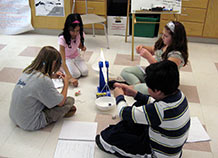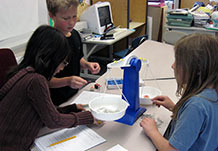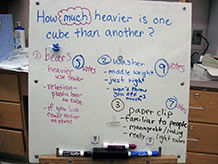How can we measure the weights of our cubes?
Plan Investigating Weight 3
Students have established the weight order of the cubes by using a pan balance to compare them with one another, but they don’t yet know what the cubes weigh. Nor do they know how much more one cube weighs than another. In this investigation, they find out — but in an unconventional way.
Students use the pan balance to weigh three of the cubes using paper clips, steel washers, and plastic bears as their units of measurement. They may use these nonstandard units separately or in combination. Either way, by the end of the investigation, students will appreciate the usefulness of a single measure for weight.
Learning Goals
- to see the importance of using a rational and shared system for measuring weight
| Sequence of experiences | ||
|---|---|---|
| 1. Ask the question | All Class | 15 Mins |
| 2. Weigh three cubes | Small Groups | 15 Mins |
| 3. Make meaning | All Class | 15 Mins |
Materials and Preparation
For the class:- Post the investigation question in a place where all students can see it.
- Make a class table on a whiteboard or flip chart for recording the weights of three cubes; an example is shown in Step 3.
- Approximately 50 grams of plastic modeling clay (for use in a demonstration)
- 1 aluminum, 1 pine, 1 oak, and 1 copper cube
- 1 pan balance
- 1 aluminum, 1 PVC, and 1 acrylic cube
- A container with a mixture of at least 25 plastic counting bears, 40 steel washers, and 85 large paper clips
- 2 pan balances
Notebook Pages
1. Ask the question
Gather students around the three demonstration cubes placed in weight order: pine, oak, and copper. Introduce the idea of “relative weight.”
- I put the 3 cubes in order from lightest to heaviest, but do you know more about the weights of the 3 cubes that we do not see?
- How could we arrange the cubes to show how much heavier the copper cube is than the others?
Let students brainstorm some ideas. Create a weight line for the class, and reinforce the understanding that the weight line shows us not only the weight order; it also shows that the two wood cubes are close in weight, while the copper cube is much heavier than either of them.


Top: Pine, oak and copper cubes in order by weight.
Bottom: Pine, oak and copper cubes on the weight line ordered by “relative weight”.
- How much heavier is the copper cube?
Let the students know that today’s investigation will help them figure out how much each cube weighs, and how far apart they should be on the weight line. Introduce the investigation question:
Remind students that in the last session they used the pan balance to compare two cubes.
- How could we use the pan balance to measure the weight of a cube?
As they share their ideas, set up a pan balance and place the aluminum cube in one pan. Then invite a volunteer to try to weigh the cube using a piece of plastic modeling clay.
Note: Plastic modeling clay is actually not a very satisfactory material for weighing the aluminum cube; there is no clear way to describe the weight once you’ve finished. However, the plastic modeling clay provides a model for how to use the pan balance with a counterweight without suggesting how the students should use the specific counters (paper clips, washers, and bears) they are given.

Check to see that everyone understands how to use the pan balance in this new way. Acknowledge that the plastic modeling clay gives only a very general idea of the weight of the cube. (The aluminum cube weights about the same as a small glob of plastic modeling clay). Let students know that their measurements will be more precise because they will weigh their cubes using objects that they can count. Show students the collection of paper clips, steel washers, and plastic bears. Distribute the collection, the cubes, and the pan balances to the students. Students will weigh the three cubes in the pan balance and record their findings.
2. Weigh three cubes

This is the heart of students’ investigation of weight, and it might get “messy” as they struggle to achieve comparability using the nonstandard measures.
The students face a quandary: They must weigh each cube, but their measures are mixed. Should they sort them out into three piles — paper clips, washers, and bears? Should they use the same measure for all three cubes, or should they use paper clips for one, washers for another, and bears for a third? Or should they create some sort of mixed unit, perhaps “1 small pile of stuff” or “10 mixed items”?
Offer no opinion on these matters. Rather, acknowledge the difficulty and ask, “What do you think?” and “Why?”
Check to see that students understand how to use the balance in this new way, that they handle the instrument carefully, and that they adjust the balance as needed. Also, make sure they record their weight measurements in their notebooks.
Have each group record their weights for the three cubes in the class table, making sure they identify the units.
3. Make meaning
Purpose of the discussion
As a result of this discussion, students recognize that they need to have a uniform or standard unit of weight in order to compare weights. If they don’t do it spontaneously, they are prompted to use the class data table to support this claim.
Provide strategies for reading the data table
What can the students discover in the class data table? First ask them to look at the data in each column.
- What can be observed about the weight of the aluminum cube? The PVC cube? The acrylic cube?
- Is the data difficult to interpret? Why?
In fact, the data is likely to be very difficult to interpret because the groups had so many different units of measure to choose from.
Next ask students to look across each row.
- Did the groups all use the same kinds of measures?
- How do the weights of the cubes compare?
- Will the data help to build a good weight line? (Probably not)
Engage students in the focus question
Based on our class data, how can we compare the weight of our cubes?
Without consensus about the unit of measure, there can be no direct comparability. Some classes will grasp this point right away; others not at all. Work toward the understanding as best you can.
| Group # | Aluminum Cube | PVC Cube | Acrylic Cube |
|---|---|---|---|
| 1 | |||
| 2 | |||
| 3 |
Note: While the paper clips will provide the most accurate measurement, students must use more than 100 of them to weigh the copper cube.
First see if any of the groups used a single unit of measure for all three cubes. If yes, ask what their reasoning was for doing so, and have them use their data to arrange the cubes in a weight line. If not, pursue the question inquiry–fashion:
- I wonder how we could compare these weights better. Who has an idea?
If this fails, propose the strategy yourself:
- What if we used just one of the measures to weigh all the cubes? Would that help?

Before voting on the class measure, students in this class listed the pros and cons of each counting unit.
Ask the class to share ideas about which unit to use: paperclips, washers, bears — or maybe some other unit altogether. Listen to the arguments for and against each unit, and then ask the class to vote. When they have agreed on which measure to use, record the decision for the class.
Return to the investigation question:
Ask the class whether they think they are closer to making a good weight line.





